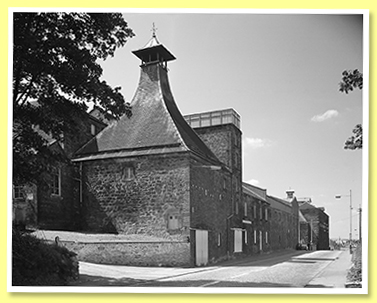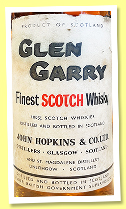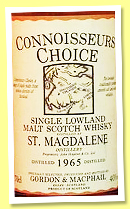| |

Home
Thousands of tastings,
all the ramblings
and all the fun
(hopefully!)



Whiskyfun.com
Guaranteed ad-free
copyright 2002-2025
|
 |
|
| Hi, this is one of our (almost) daily tastings. Santé! |
| |
|
| |
| |
June 12, 2025 |
|
  |
Important Notice:
In a rare moment of benevolence, and seizing an unexpected wave of optimism, we’ve decided to test a major improvement to WF’s layout. Namely, making the different sections of our tasting notes (colour, nose, palate, etc.) more clearly distinguishable, as has been regularly requested for, oh, the past twenty years or so.
We’ll see in a few days whether this bold move is here to stay or quietly shelved with the other good intentions. Shall we chicken out or not?
Thank you for your understanding. |
WF’s Crazy Little Duo’s,
today Glen Garry vs. St. Magdalene |
|

St Magdalene, Linlithgow (Historic Environment Scotland) |
| Not the sort of little tasting one can enjoy often, alas! We once did a Sandy Macnab versus Lochside thing, a long time ago, but I can’t even seem to get my hands on that mini session anymore. In any case, today it’ll be St. Magdalene ‘against’ its blend… |

|
Glen Garry ‘Finest Scotch Whisky’ (John Hopkins & Co, 1950s-1960s) 
This is an old bottle which shows neither ABV nor volume. Worth noting, there are ‘Glengarry’ whiskies around today which have nothing to do with this. This particular Glen Garry bottle explicitly cites St Magdalene as the malt of reference and gives one of the brand’s addresses as such, although this mention was later replaced—around the 1970s—by Oban or, in other versions, by Glen Elgin, both distilleries under DCL’s banner (The DCL had taken over John Hopkins before WWII). These distilleries were supposedly responsible for providing the main malt content for each batch, though there’s no shortage of rumours doing the rounds. What is certain is that John Hopkins was granted the licences for these DCL distilleries. Incidentally, their Oban single malts were sublime! No need to tell you that this ‘St. Magdalene’ version of this blend is much sought-after, although, as is sometimes the case, you might just stumble upon one for a few pennies if you stray outside the well-trodden paths of the connoisseurs. And to conclude this introduction—which is already far too long—I must admit I had absolutely no idea that John Hopkins at one point managed the licence for St. Magdalene.
Colour: gold.
Nose: sumptuously old-school with a puff of cigar smoke rolling through some rather earthy teas (think some stormy old pu-ehr), then a saucy shift towards marmalade jus, roast duck à l’orange style, ha, followed by those wonderfully evocative dusty old tomes and glossies banished in your attic. Drifts of wax and beehive honey appear too, as though a rogue swarm had taken up residence in the rafters half a century ago. Right…
Mouth: classically salty, metallic, loaded with chalk and concrete dust, and that familiar photolytic tang you sometimes get with some old bottles (taste of light). But here it's briskly corrected by a jolt of spicy beef broth, straight from a Bangkok street corner (that's enough two-penny travelogue, S.) With that lush oiliness you only find in those venerable blends where the malt content did the heavy lifting.
Finish: curiously persistent, as if someone had sneakily boosted it to 45% vol., with the orange bouncing back to tango with the mineral notes and bouillon spices.
Comments: a thunderous old blend, but then again, quite a few of them are when you catch them today. Case in point, the old Johnnie Walker Black – just saying… In any case, I’d wager there’s indeed quite a bit of St. Magdalene in there, along with that telltale ‘ancient’ peat. As for the grain – nowhere to be found.
SGP:463 - 90 points. |
In short, if you come across such a bottle at a small provincial auction, snap it up! Right then, for a clever, or at least entertaining, comparison, let’s taste a St. Magdalene distilled around the time this Glen Garry was released, or perhaps a bit later… |

|
St. Magdalene 1965/1991 (40%, Gordon & MacPhail, Connoisseurs Choice, ‘Old Map Label’, 75cl) 
We’ve already tasted some St. M. 1964 Connoisseurs Choice bottlings from G&M, utterly sublime despite their modest strength, but never a 1965. This high calibre is no doubt partly due to the fact that, in the mid-1960s, St. Magdalene was still performing its own floor maltings (reportedly ceased in 1968) and still using direct-fired stills (phased out in 1971). You might say, well, that didn’t stop the Rare Malts 19yo 1979 from being dazzling either, and you’d be right.
Colour: gold.
Nose: I would have loved to come off clever and claim that the blend outshone the malt in the tasting, but that’s gone straight out the window – this bottle brings back all the hallmarks of the 1964s, most notably that mind-blowing tropical fruit salad, dressed with honey and sesame, leading into a development of great complexity, with a scatter of camphor, eucalyptus, sandalwood, returning tobacco smoke, patchouli, amusing hints of mothballs, then aged citrus liqueurs and a few fine slivers of well-mannered Iberian ham. A dazzling nose, reminiscent of the Broras 1972 from the same series and years of bottling.
Mouth: very close to the old blend on the palate, which might well support the idea that there was indeed a hefty helping of St. Magdalene inside it. A thing of beauty, with citrus, waxes, gently spiced broths still leaning Thai, a touch of peat dryness, and then a parade of tiny herbs and mineral touches, tricky to tell apart but wonderfully orchestrated.
Finish: perhaps the weak spot, as is often the case at this age and strength, with a slight edge towards the cardboardy, one might say. But then again, we’re hardly going to moan, are we.
Comments: we often fret over changes to kit and process at the distilleries but rarely consider what goes on at the independents. The vats, the pipes, the filters, the warehouses, the cask selection for fillings, and so on. Still, no need to badger G&M with all that, particularly given how fruitful the early 1990s were on this front!
SGP:562 - 92 points. |
|
|
| |
|
|
|
|
|
|

